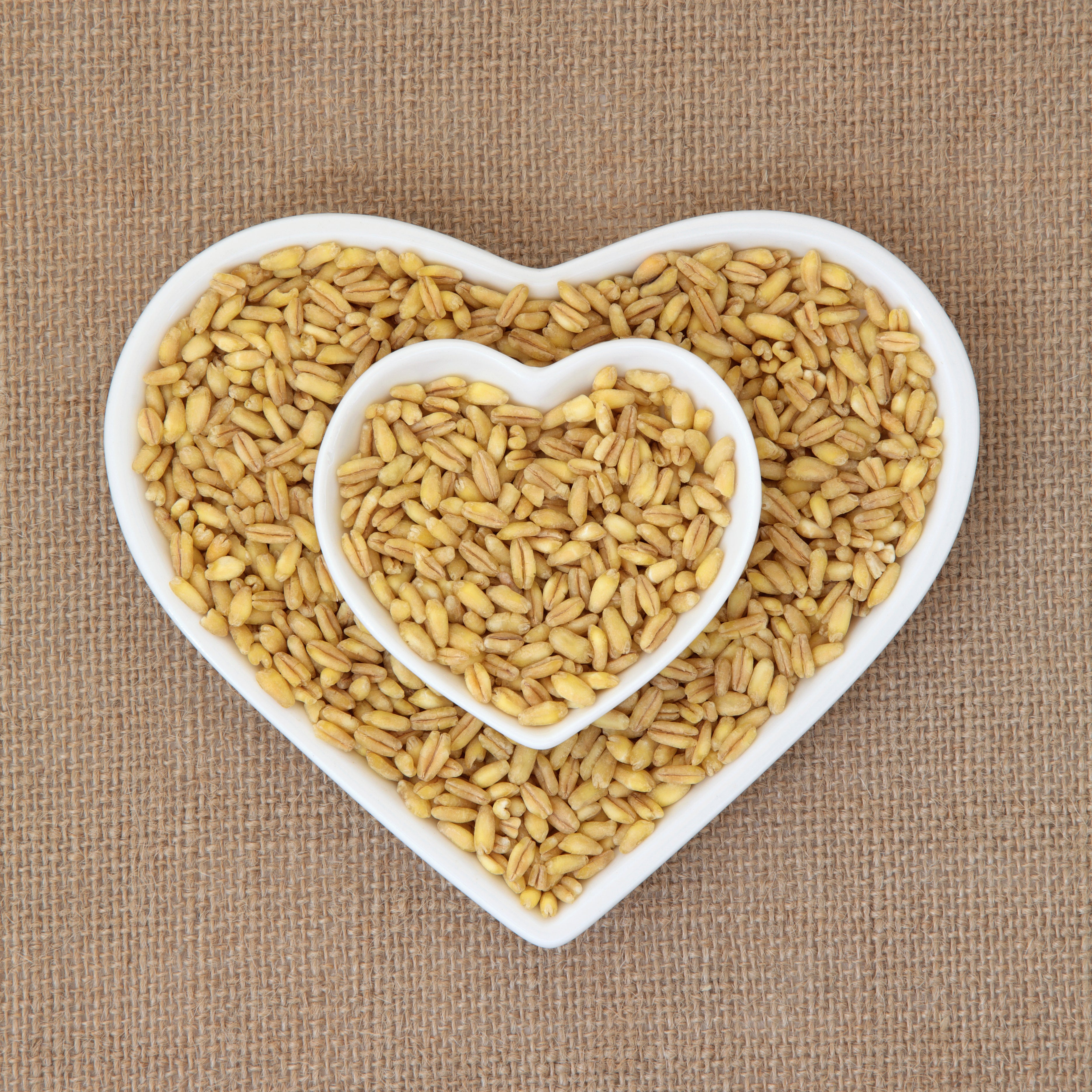Seeds of Change

Kamut khorasan wheat in heart shaped dishes over hessian background.
To prove that there is really nothing new under the sun, consider the case of the current darlings of the grain world: the wheats called farro, spelt and Kamut®. Consumers may delight in the grains’ many gastronomic possibilities, but few people realize that these ancient wheat varieties are as old as, well, King Tut’s tomb. Maybe even older.
Take the tale of Kamut, for example. Sometime after World War II, an American airman claimed to have picked up a handful of grains from a stone box in a tomb near Dashur, Egypt. He gave 36 kernels of this mysterious ancient grain to his friend Earl Deadman, who in turn sent them along to his father, a farmer in Montana.
Farmer Deadman planted the grains, harvested a small wheat crop and showed it off at a local county fair—where everyone applauded the Egyptian grain, then popularly dubbed “King Tut’s Wheat.” But the grain later named Kamut might well have then slipped into obscurity had it not been for the efforts of a second Montana wheat farmer, T. Mack Quinn, who bought the one remaining jar of this ancient wheat several decades later.
With his son, Quinn researched and propagated this type of wheat, discovering that it may not have come from an Egyptian tomb—so much for the colorful story—but it really did originate in the Fertile Crescent, which runs from the Tigris-Euphrates valley of present-day Iraq, Iran and Jordan into Egypt. The enterprising Quinns trademarked the name Kamut, an Egyptian word for wheat: Today Kamut Brand Wheat in the form of flour can be found in cereals, breads, cookies, waffle and pancake mixes and pasta, while the whole grain makes a tasty pilaf and can stand alone in other savory and sweet dishes.
What about the Italian wheat, farro (triticum dicoccum), and its cousin, the European wheat, spelt (triticum speltum)? Although not the grains of pharaohs, both have equally distinguished and ancient pedigrees. An early variety of wheat, spelt was cultivated by European farmers as far back as 5,000 BC. Farro, the popular Italian relative, reputedly was the chief sustenance of the Roman legions and, according to at least one source, may be an original strain of every subsequent wheat variety ever grown.
Because they are difficult to grow, farro and spelt fell into disfavor as farmers turned to raising the more profitable and high-yielding commercial wheat variety (triticum aestivum). Farro and spelt may have remained in obscurity if not for the demands of the gourmet and health-food market. For one thing, both are considered higher in B complex vitamins and many wheat-sensitive people can add these protein-rich grains to their diets, particularly spelt, which is easy to digest. And spelt flour can be substituted for regular all-purpose flour when making bread, cereal, cookies, pancakes and pasta.
Kamut, spelt and farro may sound like an upscale law firm, but what they really share is their ancient history as early wheat varieties. Spelt and farro are reported to be the same grain, but they are not, as neither of them is emmer, a wheat variety with which they are often erroneously linked. And the terms “spelt” and “farro” often are used interchangeably, leading to consumer confusion—so buyer beware.
Even some experts don’t always agree, since the word “farro” was the original word for “wheat” in Latin, and is the root for the Italian word for flour, farina, notes Gerardo Arias of Washington State University. If you compare the grains, however, you’ll see that farro is semi-pearled—some of its outer coating still remains after a few abrasions—and it is lighter in mouth feel than wheat berries and sweeter in taste than spelt.
The best attribute of these grains may be that they are relatively indestructible; it’s hard to kill them by overcooking. And they are quite versatile. They can be added to soups for body and enrichment.
They shine as a simple pilaf or can be treated like risotto. They make a fine stuffing for cooked vegetables or dolmas, and they can be served cold as a grain salad in the manner of tabbouleh. Because of their inherently nutty taste, Kamut, spelt and farro take to the addition of nuts quite well and pecans, walnuts, almonds and hazelnuts contribute both taste and texture. Also for increased protein, you may add cooked legumes such as lentils, chickpeas and white beans to a wheat grain dish. Granted, these grains will never be considered sexy in their own right, but they provide a neutral flavor background in which other tastes can stand out, and they have a beguiling, toothsome texture that easily makes them one of the ultimate comfort foods.